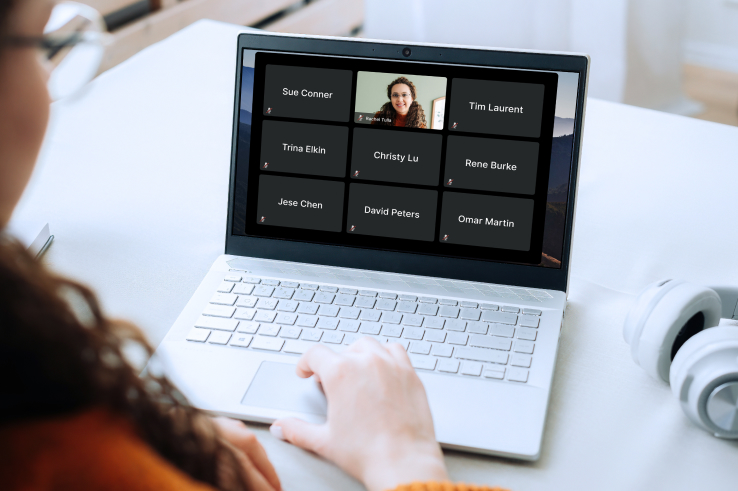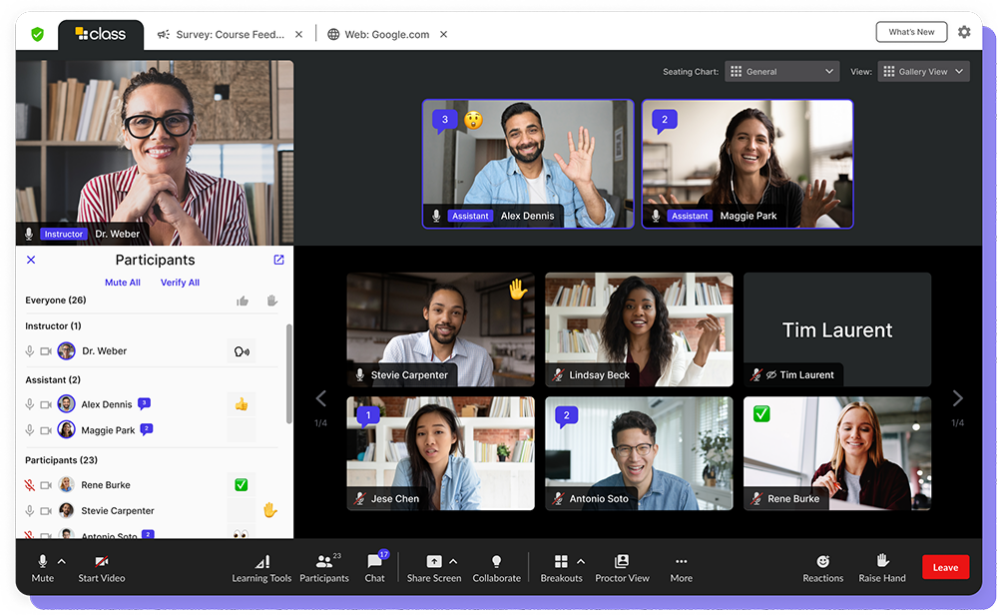
Shelby Jones is the K-12 Sales Director at Class. She’s held market-facing positions at leading EdTech companies nationally, and consults educators in their adoption of SaaS solutions for all departments. She’s passionate about start-ups, education, and technology.

Shelby Jones is the K-12 Sales Director at Class. She’s held market-facing positions at leading EdTech companies nationally, and consults educators in their adoption of SaaS solutions for all departments. She’s passionate about start-ups, education, and technology.

Teaching to a room of “camera-off learners” can present several challenges for instructors. Without visual cues from their learners, instructors can lose valuable feedback on comprehension, engagement, and overall understanding. Interactions can become one-sided, hindering the natural flow of discussion and potentially inhibiting the ability to tailor teaching methods to individual learner needs. Many instructors thrive on active participation and visual engagement, both of which can be limited when learners keep their cameras off.
But what about learner preferences? There are many reasons a learner may choose to have their camera off—from concerns about their appearance or background to wanting to address bandwidth issues. One study found that 41 percent of students said they turned their cameras off because they were "concerned about [their] appearance."
As virtual and hybrid learning continues to be more heavily embraced, the need for robust privacy features becomes increasingly more important—but should that come at the expense of a learner-inclusive classroom environment?
The “Camera on or camera off?” debate has intensified over the past few years, underscored by instructor frustrations borne out of using traditional video conferencing tools that are not purpose-built for instruction and a lack of resources and infrastructure to best support virtual programming. Rather than deciding whether learners should be required to turn their cameras on or off, what if a solution satisfies both sides?
With Class’s “Privacy Mode,” instructors can achieve the always-on camera status that can assist in providing quality instruction. At the same time, learners can secure the privacy they desire by remaining “camera off” to their peers.

With customizable privacy modes, users can tailor their online learning experience based on their preferences, comfort, and current circumstances without limiting the instructor’s ability to assess their engagement and allowing students to still feel seen—both literally and figuratively—by their instructor. Visual cues can play a crucial role in understanding and retaining information during online interactions, underscoring the importance of camera-on learning.
There are circumstances, however, where a learner may not want their surroundings presented to their fellow learners. A worker needing to look after a sick child may not want to show their home in the background during specific training sessions, but they want to stay on track with their upskilling or reskilling programming. A student who shares a dorm room with a roommate may be selective when they want to be on camera, as well. An elementary school child may find too many additional camera views distracting from the learning itself. With customizable privacy modes, these learners can still benefit entirely from camera-on engagement without compromising privacy or attention.
While the examples above are circumstances where a learner or instructor may not want to provide visual access to all participants into the background of their current location, instructors need camera-on visibility in order to best facilitate coursework. Per Hrastinski’s study published in Educause Quarterly, the instructor’s ability to see learners allows for better monitoring of comprehension and attention levels, enabling them to adjust their instructing techniques and strategies accordingly.
By leveraging the power of top-end virtual classroom platforms such as Class’s “Privacy Mode,” instructors can maintain visibility at all times while allowing learners to choose when and how they want their camera visible to other participants, as noted in the examples above. However, by keeping the instructor with full access, seamless communication, feedback, and guidance can be facilitated more effectively in the teaching-learning process.
At the cornerstone of effective learning environments is the ability to create and foster trust between instructor and learner, as well as between peers. Through customizable privacy mode controls, instructors demonstrate a deep commitment to respecting learners’ preferences—and privacy. This transparency can encourage active engagement and collaboration, enhancing the virtual learning experience even further.
For instance, instructors may enable camera visibility during group discussions or collaborative activities to encourage participation and foster a sense of connection among learners. Alternatively, for tasks requiring individual focus or reflection, instructors can allow learners the option to disable their cameras temporarily, providing them with the autonomy to engage with course materials in a manner that suits their learning style best.
While instructors ultimately can toggle privacy settings to best benefit participants' overall learning experience, top-end online classroom platforms like Class allow for the choice to rest with the learners, as well. Class not only gives instructors control of camera-on moments, but it also allows instructors to defer to individual learners with the “let learners decide” feature, enhancing the formation of trust, which is vital to an ideal learning environment.
There are numerous reasons why online learners often desire to remain camera-off; however, privacy mode allows instructors a path forward while still respecting learners’ privacy and needs. The ability to keep learners engaged is paramount to successful teaching. By opening the ability for camera-on learning to occur only with the instructor, both learners and instructors benefit while still allowing for privacy, security, and trust to remain intact. Online learning privacy settings can be a gateway to an even better learning experience.
Are you ready to empower your online instructors with flexible privacy views? Reach out to a Class team member today, and let’s enhance the learner experience while still prioritizing privacy, trust, and communication.

Shelby Jones is the K-12 Sales Director at Class. She’s held market-facing positions at leading EdTech companies nationally, and consults educators in their adoption of SaaS solutions for all departments. She’s passionate about start-ups, education, and technology.

Shelby Jones is the K-12 Sales Director at Class. She’s held market-facing positions at leading EdTech companies nationally, and consults educators in their adoption of SaaS solutions for all departments. She’s passionate about start-ups, education, and technology.
Get our insights, tips, and best practices delivered to your inbox

Sign up for a product demo today to learn how Class’s virtual classroom powers digital transformation at your organization.

Features
Products
Integrations